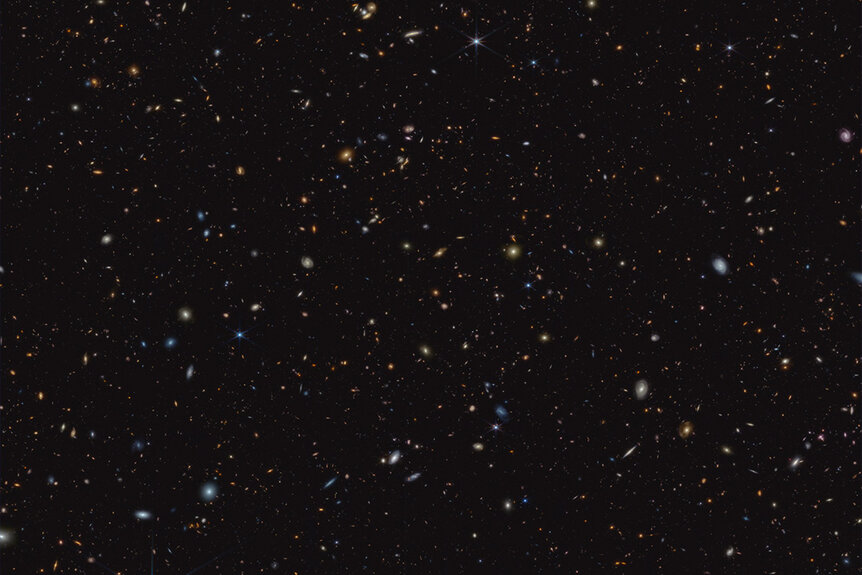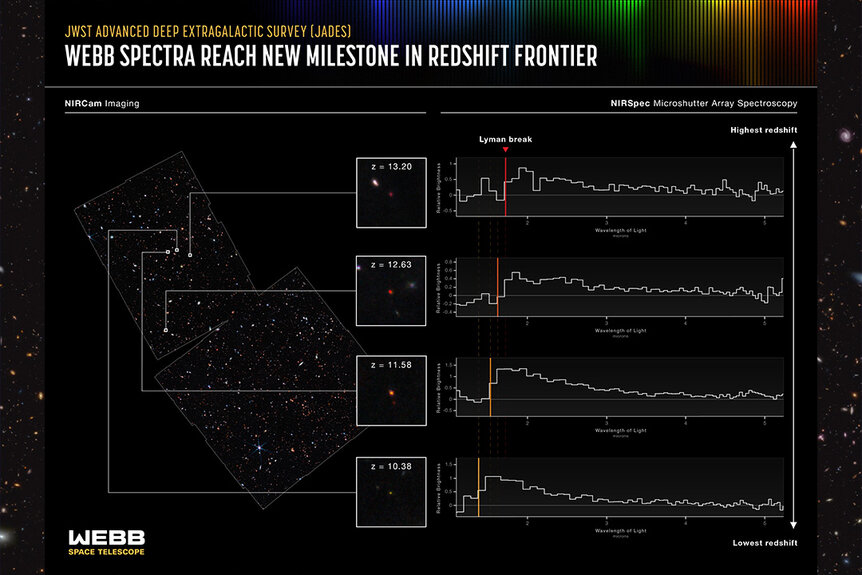Create a free profile to get unlimited access to exclusive videos, sweepstakes, and more!
JWST May Have Found Dark Matter Stars in the Early Universe
Things just keep getting weirder with the discoveries made by the James Webb Space Telescope.

Living vicariously through the astronaut John Crichton (Ben Browder), fans of Farscape — streaming now on Peacock — got to experience parts of the cosmos and its many varied inhabitants. Every day (read: every episode) was some new adventure filled with beautiful cosmic scenery and interesting characters.
Here at home, in the real world, everything looks pretty ordinary, but NASA’s James Webb Space Telescope (JWST) may have just picked up something truly bizarre at the edge of the observable universe. A team of astronomers, poring over deep sky data from JWST, may have found three massive, early stars powered by dark matter, according to a new study published in The Proceedings of the National Academy of Sciences.
JWST Finds Very Old Galaxies at the Edge of Space
Astronomers largely group stars into one of two categories, based on how much metal they have. Population I stars are metal-rich, while Population II stars are metal-poor. Knowing how much metal a star is harboring tells you something about when and how it formed, because metals are only produced inside of other stars. While Population II stars have relatively low metal contents, they still have more metal than they could have gotten from the primordial gas leftover after the Big Bang. All of which suggests that even Population II stars are still second generation stars at the very least, having gobbled up metals from dead stars that came before.
The bottom line is we've never seen a star from the beginning of the universe, and we know that because every star we've ever seen must have gotten its metals from some other star that came earlier. With that in mind, astronomers have been on the hunt for hypothetical Population III stars, composed entirely of hydrogen and helium from the Big Bang, with tiny amounts of lithium and beryllium. Finding a Population III star would be a surefire way to know we're looking at one of the first things to form after the creation of the universe. Unfortunately, to date no such star has been observed.
Over the first year of JWST's life in space, it spent roughly 32 days on a project called the JWST Advanced Deep Extragalactic Survey (JADES). The project's aim is to capture light from the most distant objects at the edge of known space and learn about the earliest parts of our universe. Already, JADES has identified hundreds of galaxies, each of which existed within the first 600 million years after the Big Bang.
The discovery poses a potential problem for the standard model because some of those galaxies appear too mature to exist as early as they did. Which is exactly the sort of paradigm-shattering science JWST was intended for. Despite finding more galaxies than we could have hoped for, JWST has so far seen no evidence of Population III stars in its deep sky data.
Are They Galaxies or Dark Matter Stars?
In 2007, astronomers suggested another possibility for the earliest stars to emerge after cosmic dawn, and it involves a boat load of dark matter. Instead of the ordinary fusing of hydrogen which lights up normal stars, these hypothetical dark stars would be fueled almost entirely by dark matter.
RELATED: Dark Matter May Have Come From a Second, darker Big Bang
The idea is that the early universe would have been jam-packed with untainted hydrogen, helium, and more dark matter than you could possibly want. Massive clouds of hydrogen and helium would have begun forming, much like an ordinary star, but then dark matter gets into the mix.
See, some scientists suggest that dark matter particles are their own antiparticles. That means that anytime two dark matter particles come together, they annihilate one another, transforming into energy and heat. If you gathered a bunch of hydrogen, helium, and dark matter together in the early universe, the heat from the constant dark matter annihilation might take the place of fusion in the creaton of a dark star.
If they are, in fact, dark stars, they are monsters. Dark matter heating would cause these dark stars to swell to incredible sizes and masses. Scientists estimate they'd weigh in at roughly 10 million times the mass of the Sun and shine with the light of 10 billion stars.
Much like Population III stars, dark stars are only hypothetical, but if any telescope is going to find one or both of them, it's JWST. The road to this current paper, and the potential discovery of the first dark stars, begins with another study published earlier in 2023, in the journal Nature Astronomy. Emma Curtis-Lake from the University of Hertfordshire, and colleagues, performed spectroscopid data on four objects from the JADES data and confirmed redshifts dating them to 320 - 400 million years after the Big Bang. The new study challenges that assessment and suggests instead, that three of the four objects are actually dark stars.
“When we look at the James Webb data, there are two competing possibilities for these objects. One is that they are galaxies containing millions of ordinary, population-III stars. The other is that they are dark stars. And believe it or not, one dark star has enough light to compete with an entire galaxy of stars," said study author Katherine Freese, in a statement.
As with all things in science, additional observations could confirm the existence of dark stars, opening up a new avenue of dark matter research, or we'll learn that something else, potentially much weirder, is going on.
In the meantime, you can explore the universe (at least an incredible fictional one) yourself in Farscape, streaming now on Peacock!




























